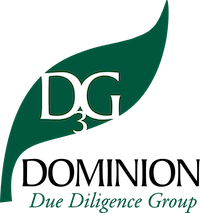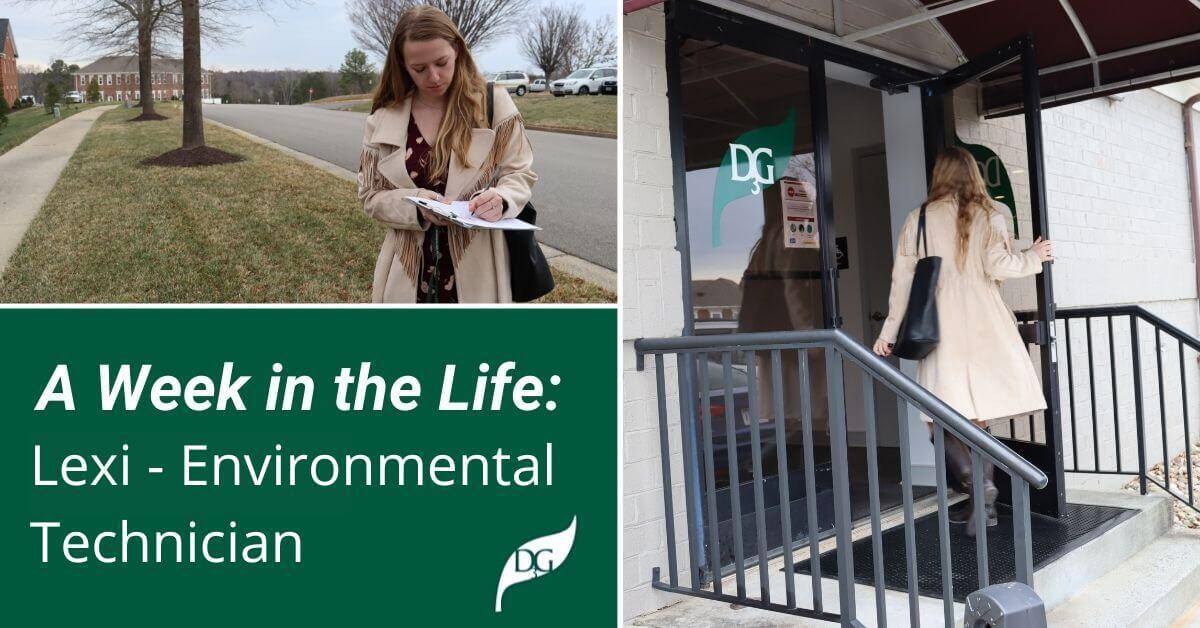
Week in the Life Blog Series:
Lexi - Environmental Technician
Monday
My day starts at 7:45 in the morning. I give my cat Cheddar a quick scratch on the head and make sure I have everything I need before heading out the door.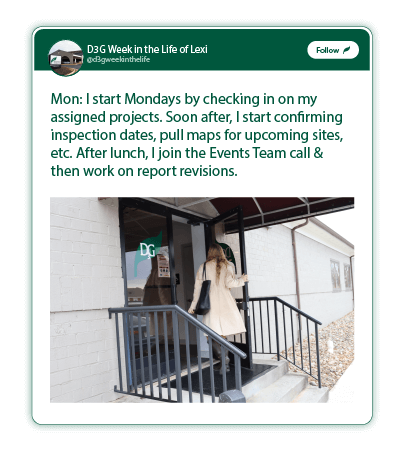
I arrive between 8:30 and 9:00 am every morning. My first task for the day is to check on assigned projects sent over by my manager. I then spend some time reviewing my ‘To-Do’ list I made the day before. This helps me prioritize my tasks and determine what I need to get completed by the end of the day. Projects pass through many hands, so it’s important for me to be timely with my tasks, keeping the process as efficient as possible before handing the project over to my supervisor or other departments to ensure deadlines are met.
Soon after, I begin emailing my site contacts to confirm inspection dates or send them an initial user questionnaire to gather more information and history about their property site. For the next few hours, I will work on pulling maps, specifically tax maps and aerial maps to start the information gathering process on my next site. Eventually, I will be visiting these sites on inspection. Early information gathering and coordinating future travel are two key pieces to any successful project.
As I work through each assigned project, I make sure to update our Project Manager system to track which tasks I’ve completed. With data collection being so important at D3G, our Project Manager system helps our team stay on track. There can be upwards of 10 different people working on the same project in different capacities. Project Manager helps us effectively communicate with one another. Aside from the team communication, it’s not uncommon for me to work on multiple projects at once. Tracking my progress is helpful when I need to refer or check on tasks that still need to be completed.
After lunchtime, I join the Events Team call. The Events Team is one of 6 action groups we have in the office. This meeting is a nice break from my everyday assignments. It gives me a chance to collaborate with other coworkers outside of my department. We discuss and plan for upcoming company events such as food trucks, happy hours, and off-site events – most recently we hosted a salsa competition. Typically, we try to do something for our staff on a regular basis, with bigger events every quarter. It’s a huge benefit for our company culture, and it’s something everyone can enjoy.
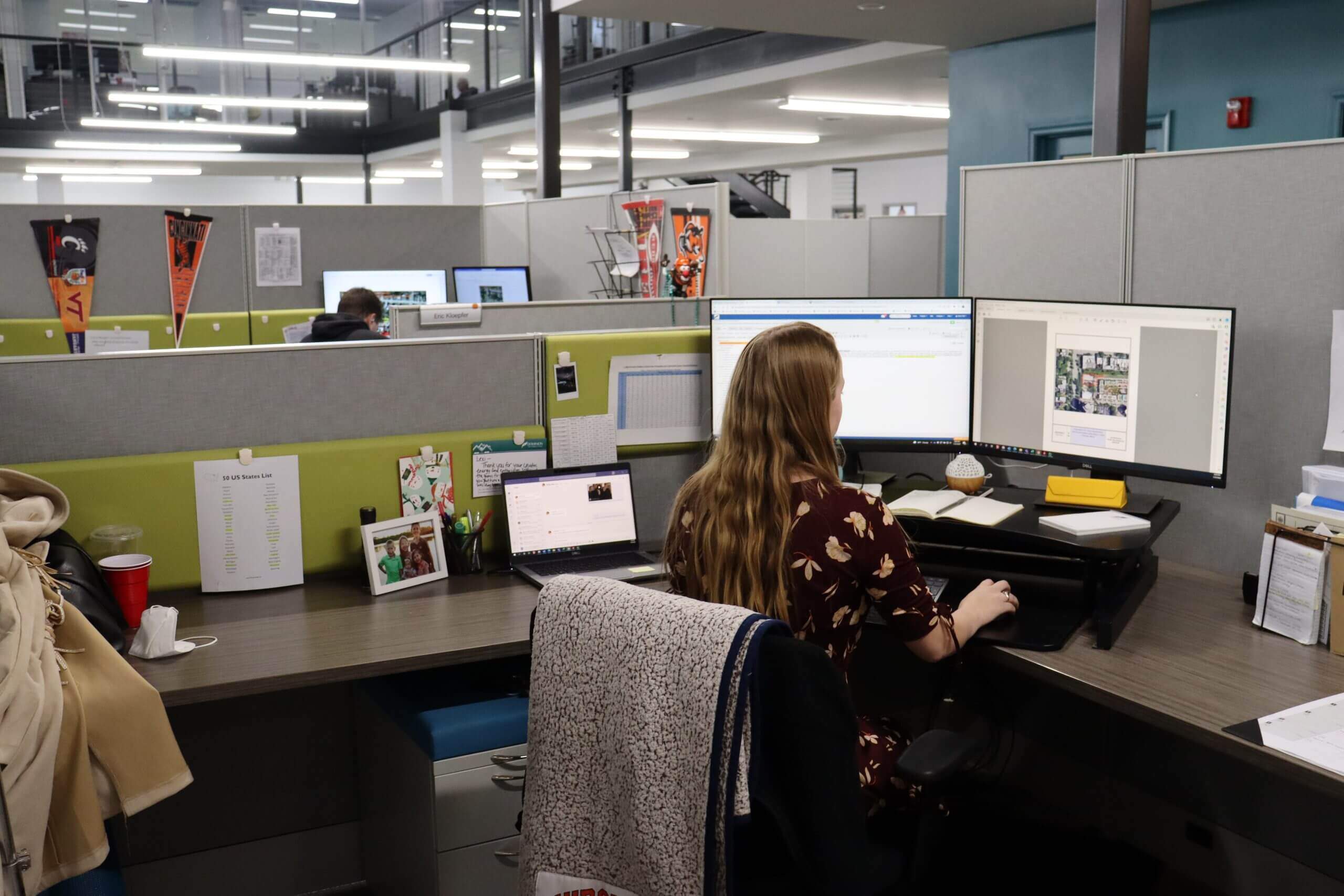
Following the Events Team meeting, I spend the remainder of the afternoon working on report corrections sent over my Review/Revisions Manager. The Review/Revisions Manager role at D3G is an Environmental Professional that reviews and revises reports and makes any suggestions and/or corrections necessary. My corrections usually include grammatical errors, redrawing boundary lines, or specific write-up changes. We work together to amend the report, which is always a welcomed opportunity for learning. I finish up the day by drafting the project report I started late last week.
Tuesday
It’s site plan day! Luckily, with the help of many tools that are available to me, I am able to create a ‘best-guess’ site plan that includes all of the pertinent information I have gathered to date. I collect this information based on a checklist that ensures all steps are completed.
I use the maps I pulled yesterday to identify what’s around the project site, including existing conditions and areas of concern that may affect the eligibility of the property, as well as the surrounding environment. I start by locating the boundary lines of the project site and notating features such as sensitive adjoining land use, wetland features, floodplains, aboveground storage tanks, pipelines, overhead transmission lines, and railroad tracks – just to name a few. In addition to the physical site, there are other factors like surrounding neighborhoods, architecture, and zoning requirements that can affect the eligibility of a site. I began the Field Data Sheet (FDS), which is a standard data-gathering tool for use across all inspections. It’s used to note important factors that may be found during an inspection and is very helpful when visiting the physical property.
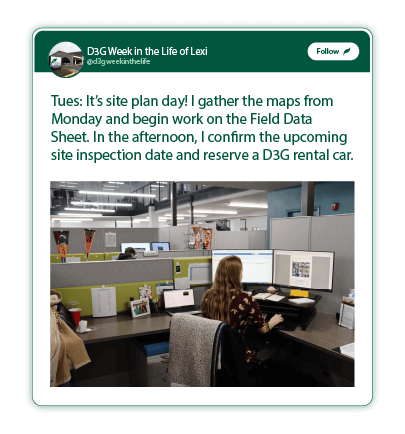
By the afternoon, I take a break from site planning to send out a companywide Green Door email. The Green Door is our company intranet; it serves as a repository for important documents and quarterly updates, as well as a virtual community where our staff can share photos, thoughts, and local happenings. I have been a part of The Green Door communications team for about a year now, and I especially enjoy posting content and articles I think my coworkers will find interesting or funny.
It’s the end of the day, and I have just received confirmation for my site inspection on Thursday in North Carolina. I reserve one of D3G’s car rentals which is convenient for projects within several hours of the office. When the inspection site isn’t drivable, I’ll fly. While flying does require more time and planning, it has taken me to some neat spots around the US. Before leaving the office, I make sure to update Project Manager so that my team knows I will be on a site inspection later this week.
Wednesday
The state and federally-regulated database report ordered from EDR (Environmental Data Resources, Inc.) for the North Carolina project is in my inbox today. I open the report and find that there are contamination listings on and near the subject property. I use the tools EDR has to estimate groundwater flow in the vicinity of the site in order to determine the relevancy of the listings. Following this, I use EDR’s online reporting writing platform called PARCEL to create the Phase I Environmental Site Assessment (ESA) and HUD Environmental Review (ER) templates and begin pre-writing. There are a lot of sections that I can write before I even set eyes on the site, which is a great way for me to be efficient with my time.
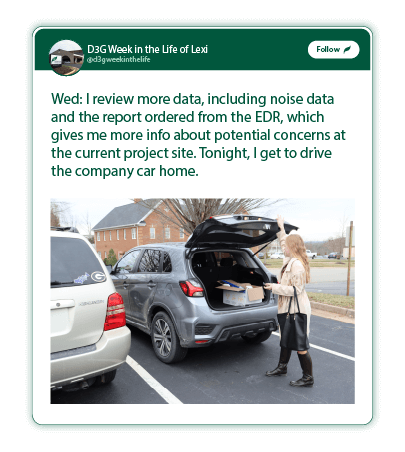 Later, I make sure to pull all noise data for this new construction project. I identify airports, railroads, and major roads that are within specified distances from the subject property. These are considered noise sources. This data should be pulled as soon as possible. Often, it’s necessary to contact outside sources to obtain the correct data for the noise sources, which can take several days to get. It’s important that I update the Noise Data task in Project Manager to let my colleague Meagan Clark, NEPA Specialist II, know that the project is in motion.
Later, I make sure to pull all noise data for this new construction project. I identify airports, railroads, and major roads that are within specified distances from the subject property. These are considered noise sources. This data should be pulled as soon as possible. Often, it’s necessary to contact outside sources to obtain the correct data for the noise sources, which can take several days to get. It’s important that I update the Noise Data task in Project Manager to let my colleague Meagan Clark, NEPA Specialist II, know that the project is in motion.
It's fulfilling to know that my careful completion of each step is used to ensure safe and healthy living environments for current or future occupants of the project site.
In preparation for my site inspection tomorrow, I drive the company car home so that I can hit the road early.
Thursday
I hop in the car at 7:00 and make my way to North Carolina. I take this time to listen to music or catch up on an audiobook until I arrive on-site by 11:00.

I walk into the leasing office and introduce myself to the site contact. After introductions, I waste no time getting started! I am required to inspect 10% of all units. The unit sample should represent all unit types, including handicapped, vacant, and down. In addition to the dwelling units, I also inspect:
- Common areas like the leasing office, community room, and maintenance buildings.
- Site features include signage, parking lots, retaining walls, and playgrounds.
- Utilities such as HVAC, water, electrical, and elevators.
- Adjacent properties to the site, including fields, parks, and/or existing buildings.
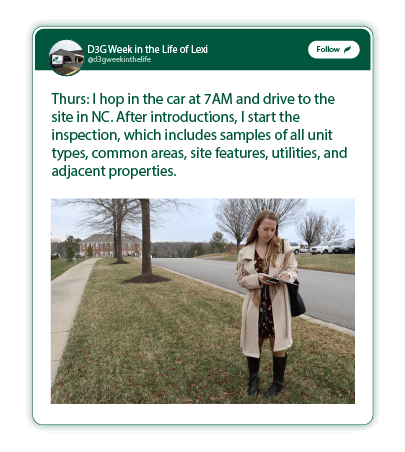
While walking the property, I take photos and document comments, notes, and deficiencies on the FDS I started on Tuesday. This information is used to complete the inspection checklist and create a photo log of the site to depict the overall condition of the property. The properties we most often inspect are multifamily apartments, commercial buildings, vacant land, or historic buildings. Depending on the size of the site, an inspection can take a few hours or up to a few days for the more scattered site projects. I’m able to wrap this one up in about two hours, and I hit the road before 3:00.
Today’s inspection only took a few hours, but overnight inspections present their own unique opportunities for fun and adventure. For an overnight inspection that may take a few days, I often try to find fun things to do in the city after work – dinner, museums, parks – you name it. Depending on where I’m headed, I might even have a chance to meet up with family and friends living in different states. This is a nice perk of the job that I try to take advantage of when I can.
Before dropping off the rental car, I refill the gas tank and park it back at the office. It’s been a long day, but I am looking forward to seeing Julian and Cheddar this evening.
Friday
On most Fridays, I work from home! This is a particularly nice benefit after returning from an inspection.
One of the biggest priorities following an inspection is sharing what I learned with my team, uploading inspection photos and notes into the project folder, and speaking with any other colleagues who are involved with the project.
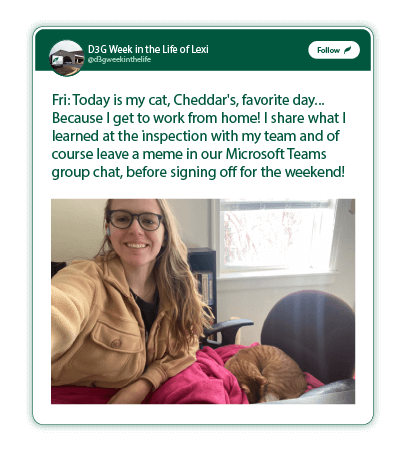
At 10:30, I join the Community Engagement Committee meeting, where we discuss and plan different service opportunities that our company can participate in. Our focus area this month is Children & Youth. I’m excited to update the group on a few service opportunities I tracked down last week.
Following that meeting, I worked on NEPA (National Environmental Policy Act) correspondence for my project. Depending on the project, some typical NEPA compliance areas include Historic Preservation, Endangered Species, and Coastal Zone Management. I try to have this work done within three days of the inspection. Because we work with various agencies, it’s not uncommon for a month to go by before obtaining all the information needed.
In order to submit my NEPA packages, I must complete the following: writing the Executive Property Description, writing the Summary of the Subject Property History, completing the photo log, finalizing the site plan, and ensuring that I have all the applicable maps ready. After I package these documents up, I send off an email to the NEPA Compliance Division, and they take care of the rest! And yup – you guessed it, back to Project Manager to update this completed task.
At the end of the day, I make sure to create another To-Do list for Monday, so I can pick up right where I left off and get to work! Before departing for the weekend, my coworkers and I wish each other a happy weekend in the Microsoft Teams group chat, followed by an endless series of memes and gifs.
I click out of my applications, shut down my laptop, and enjoy the weekend before preparing for the week ahead.
Follow D3G for more industry updates.
Learn more about how D3G helps improve multi-family housing.

